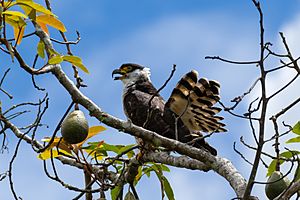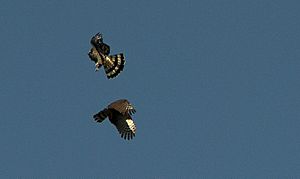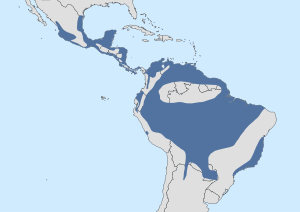Hook-billed kite facts for kids
Quick facts for kids Hook-billed kite |
|
|---|---|
 |
|
| Hook-billed kite in Pasco, Peru | |
 |
|
| Conservation status | |
| Scientific classification | |
| Genus: |
Chondrohierax
|
| Species: |
uncinatus
|
| Subspecies | |
|
|
 |
|
The hook-billed kite (Chondrohierax uncinatus) is a special type of bird of prey. It belongs to a family called Accipitridae. This family also includes other cool birds like kites, eagles, and harriers. You can find hook-billed kites in many parts of the Americas. They live in places like the Rio Grande Valley of Texas in the United States, Mexico, the Caribbean islands, Central America, and warm parts of South America.
Contents
What Does a Hook-billed Kite Look Like?
The hook-billed kite is a medium-sized bird. It has a slim body with stripes on its belly and bands on its tail. These birds can look very different from each other. Their colors and the size of their beaks can vary a lot.
Some hook-billed kites might look black or gray, especially the males. Females often appear brown or brick-red. This wide range of colors can sometimes make it hard to tell them apart from other birds. When a hook-billed kite is sitting or flying low, you can clearly see the special hook at the tip of its beak.
These birds usually weigh between 215 and 397 grams (about 7.6 to 14 ounces). They are about 38 to 51 centimeters (15 to 20 inches) long.
What Do Hook-billed Kites Eat?
Tree snails are a very important food for the hook-billed kite. Where there are many tree snails, you will likely find more hook-billed kites. Scientists have even noticed that the size and shape of the kite's beak can change. This change depends on the type of tree snails available in different areas.
Even though snails are their main food, hook-billed kites also eat other things. They might hunt frogs, salamanders, small mammals, and insects. When a kite finds a tree snail, it holds the snail with its strong talons. Then, it uses its hooked beak to carefully open the snail's shell.
Life and Habits
Hook-billed kites build their nests from sticks. Both the male and female birds help to build this simple platform. The female kite usually lays two or three eggs. These eggs are buff-white with red-brown marks.
Both parents take turns sitting on the eggs to keep them warm. This is called incubation. Once the chicks hatch, they stay in the nest for about 35 to 45 days. Both parents also help feed the young birds.
These raptors are often described as quiet and not very active. They prefer to sit hidden inside leafy trees when they are not flying.
Related Species
There is another bird called the critically endangered Cuban kite (C. wilsonii). Some experts believe that the Cuban kite might actually be a type of hook-billed kite.
See also
 In Spanish: Milano picogarfio para niños
In Spanish: Milano picogarfio para niños


